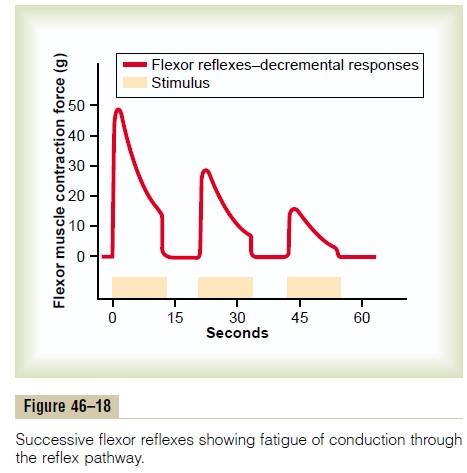Chapter: Medical Physiology: Sensory Receptors, Neuronal Circuits for Processing Information
Instability and Stability of Neuronal Circuits
Instability and Stability of Neuronal Circuits
Almost every part of the brain connects either directly or indirectly with every other part, and this creates a serious problem. If the first part excites the second, the second the third, the third the fourth, and so on until finally the signal re-excites the first part, it is clear that an excitatory signal entering any part of the brain would set off a continuous cycle of re-excitation of all parts. If this should occur, the brain would be inun-dated by a mass of uncontrolled reverberating signals—signals that would be transmitting no infor-mation but, nevertheless, would be consuming the cir-cuits of the brain so that none of the informational signals could be transmitted. Such an effect occurs in widespread areas of the brain during epileptic seizures. How does the central nervous system prevent this from happening all the time? The answer lies mainly in two basic mechanisms that function throughout the central nervous system: (1) inhibitory circuits and (2) fatigue of synapses.
Inhibitory Circuits as a Mechanism for Stabilizing Nervous System Function
Two types of inhibitory circuits in widespread areas of the brain help prevent excessive spread of signals: (1) inhibitory feedback circuits that return from the termini of pathways back to the initial excitatory neurons of the same pathways—these circuits occur in virtually all sensory nervous pathways and inhibit either the input neurons or the intermediate neurons in the sensory pathway when the termini become overly excited; and (2) some neuronal pools that exert gross inhibitory control over widespread areas of the brain—for instance, many of the basal ganglia exert inhibitory influences throughout the muscle control system.
Synaptic Fatigue as a Means for Stabilizing the Nervous System
Synaptic fatigue means simply that synaptic transmis-sion becomes progressively weaker the more pro-longed and more intense the period of excitation. Figure 46–18 shows three successive records of a flexor reflex elicited in an animal caused by inflicting pain in the footpad of the paw. Note in each record that the strength of contraction progressively “decrements”— that is, its strength diminishes; much of this effect is caused by fatigue of synapses in the flexor reflex circuit. Furthermore, the shorter the interval between successive flexor reflexes, the less the intensity of the subsequent reflex response.

Automatic Short-Term Adjustment of Pathway Sensitivity by the Fatigue Mechanism. Now let us apply this phenomenonof fatigue to other pathways in the brain. Those that are overused usually become fatigued, so that their sensitivities decrease. Conversely, those that are underused become rested, and their sensitivities increase. Thus, fatigue and recovery from fatigue con-stitute an important short-term means of moderating the sensitivities of the different nervous system cir-cuits. These help to keep the circuits operating in a range of sensitivity that allows effective function.
Long-Term Changes in Synaptic Sensitivity Caused by Automatic Downregulation or Upregulation of Synaptic Receptors. Thelong-term sensitivities of synapses can be changed tremendously by upregulating the number of receptor proteins at the synaptic sites when there is underac-tivity, and downregulating the receptors when there is overactivity. The mechanism for this is the following: Receptor proteins are being formed constantly by the endoplasmic reticular–Golgi apparatus system and are constantly being inserted into the receptor neuron synaptic membrane. However, when the synapses are overused so that excesses of transmitter substance combine with the receptor proteins, many of these receptors are inactivated and removed from the synap-tic membrane.
It is indeed fortunate that upregulation and down-regulation of receptors, as well as other control mech-anisms for adjusting synaptic sensitivity, continually adjust the sensitivity in each circuit to almost the exact level required for proper function.Think for a moment how serious it would be if the sensitivities of only a few of these circuits were abnormally high; one might then expect almost continual muscle cramps, seizures, psy-chotic disturbances, hallucinations, mental tension, or other nervous disorders. But fortunately, the auto-matic controls normally readjust the sensitivities of the circuits back to controllable ranges of reactivity any time the circuits begin to be too active or too depressed.
Related Topics